STITCHES,
BITCHES
AND
A FEW STRANDS OF PUBIC HAIR
by
KRISTEN PAUCH-NOLIN
____________________
Kristen
Pauch-Nolin is a Winnipeg artist, curator, and a regular contributor
to Galleries West and Uptown magazines.
Over the past four
decades the feminist movement has broken barriers by having
both women and craft practice recognized within the art world.
Activities such as embroidery, fibre arts, ceramics, and jewellery-making
-- frequently regarded as women’s busy work -- now inhabit
contemporary art discourse. For women artists, the association
of craft practices with female culture continues to provide
an opportunity to create female images and explore issues of
significance to women, using media that has great significance
within their distinct history.
Informed
by both current feminist discourse and art theory, Manitoba
artists Cecile Clayton-Gouthro, Margi Hennen, JoAnna Lange and
Aliza Amihude, produce works of art that allow the processes
and materials used in the creation of their pieces to have conceptual
significance. Working with thread, clay, fibre and metal each
artist creates contemporary and transcendent works of art that
are easily classified as both feminist and craft.
Cecile
Clayton-Gouthro chronicles the lives of women through the creation
of beautifully crafted thread drawings. Each of the drawings
measures approximately 3" x 4" and includes a precisely
rendered image inspired by life. Visual interpretations of two
such encounters -- the first featuring a middle aged female
motorcyclist and the second the memory of a wedding that she
attended as a child -- result in captivating and challenging
works of art.
Each
of the pieces is carefully drawn by hand, using a needle and
a variety of silk and cotton threads to form an image. As each
drawing emerges, Cecile allows the physical act of stitching
and the weave of the fabric to influence the features, activities
and even the gender of her characters.
In
"Born on a Friday," Cecile presents the image of a
strikingly strong woman clothed in leathers and a skull cap,
engaged in a game of bowling. Here the character, inspired by
the artist’s encounter with a woman and her motorcycle,
captures our imagination with the spiritedness and unorthodox
appearance of the main subject. Her full body and proud stance
signal a complete strength usually reserved for images of men.
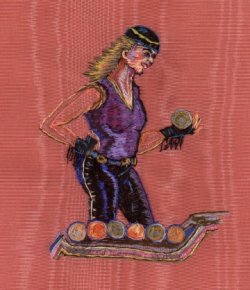
The
juxtaposition of the physicality of the female subject against
the delicacy of the materials used to create the work reinforces
the piece’s ability to circumvent existing notions about
women and embroidery. “Born on a Friday” successfully
challenges any remaining preconceptions of females as pacifists
and about embroidery as simply a woman's pastime.
The
significance of both the subject and the media is once again
essential in accessing the meaning of Cecile’s “Bow
Tied.” Similar to “Born on a Friday,” the
piece includes the central image of a female figure drawn using
a variety of coloured silk threads.
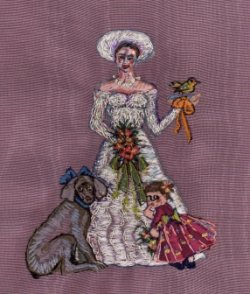
The
composition is central and formal including a bride, a dog,
a bird and a young girl. In stark contrast to our expectation
of sentimentality based on the matrimonial theme, the presentation
of the bride is stiff and expressionless. It is an odd and generic
representation rather than a portrait of someone specific. Contributing
to the unusualness, the inclusion of animals in the grouping
suggests additional symbolic possibilities.
Both
“Born on a Friday” and “Bow Tied” demonstrate
the ability of embroidery to function as a powerful and multi-capable
art media. By exploiting both its historical significance and
its communicative potential, Cecile is able create a contemporary
work of art that celebrates the lives of women in a media that
is significant to their history.
Doll
maker Margie Hennen similarly views her work as an opportunity
to "chronicle and celebrate women's lives." Her work
involves the construction of female forms out of a variety of
fabrics and found objects.
Each
piece begins with an idea inspired by an event, person or experience
which is developed through the construction of her work. Fashioned
out of fabric that has been intensely manipulated by dying,
painting, printing etc. the finished works evolve into animated,
politically charged doll sculptures.
As
a maker of dolls, she allows the strong associations with the
objects that she creates to contribute to the works’ conceptual
meaning. Traditionally, dolls are objects that inhabit female
culture. They function as purely decorative pieces, are used
as security objects or are employed as maternal training tools
for young girls. Margie exploits the power and universality
of these associations to create contemporary art work that advances
her strongly feminist views.
“Endangered
Species,” presents three outfitted female figures using
boldly patterned fabrics and constructed in the shape of diamonds.
Each piece is individually titled with a combination of two
words. First, the adjective fat appears in crude reference
to the doll's physical size. It is followed by the name of a
living species represented by a pattern appearing on the doll's
dress.
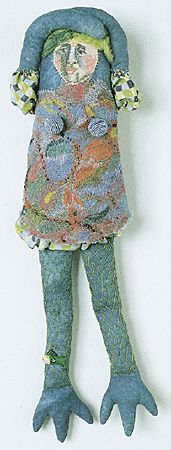
Through
this skillful combination of elements, Margie creates a compelling
parallel between endangered ecological species and societal
obsession with body transformation. As a result, “Endangered
Species” reveals that as a result of contemporary culture’s
preoccupation with thinness, women of larger stature are at
risk of becoming both figuratively and literally extinct. 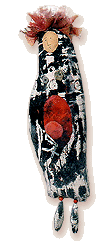
Society’s
obsession and lack of respect for women's bodies is once again
called into question in “Diana." On a warm day in
the Ephesian forest, Diana can unsnap her breasts, slip them
into her tit bag and go on her way, offending no one. Here,
the female form is shown naked from the waist up with multiple
breasts fastened onto her torso with snaps. In her right hand
she holds a bag, the eventual receptacle for her breasts once
they are removed.
Exploring
volatile issues through craft demonstrates the ability of the
medium to present politically explosive subjects without becoming
didactic. Margie’s confrontation of feminist concerns
is unequivocal. Creating art out of objects so deeply entrenched
within female experience results in work that by its very creation
is political. The finished dolls exist as subversive tallis-objects
capable of inciting reflection, dialogue and change.
The
desire to enact change through the creation and presentation
of craft objects also inspires ceramic artist JoAnna Lange’s
installation pieces. Her sculptural works feature stylized clay
women presented as multiples. Two of her most recent works,
“Trophy Wives” and “Good Girls,” (à
la Margie Hennen) explore issues related to society’s
negative attitudes toward women and their bodies.

Although
clearly inspired by history, each of the pieces includes elements
that position the work firmly within contemporary art practice.
Each of the clay statuettes are unmistakable representations
of modern women exploring current issues. The infusion of humour
into the work through the playful rending of the clothing and
facial features reinforces the very modern approach that the
artist is taking.
JoAnna's
installation “Trophy wives” features three groupings
of such female forms. Each grouping includes four minimal, trophy
inspired, fanciful clay statues. The statues appear as robust
figurines, glazed with fired on gold lustre (24 carat) and embellished
with floral decals. Naked to the waist, the addition of pendulous
breasts and correctly placed genitals attached to the outside
of their skirts comically emphasizes the gender of each statuette.
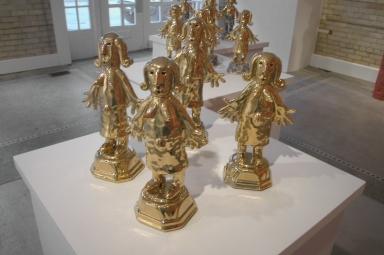
With
biting humour, these trophy women possess all of the attributes
of age and maturity. In stark contrast to the expectation implied
by the title, here it is mature women who are prized rather
than their younger counterparts. In fact, JoAnna contends that
it is not the second wife that is the trophy but the first.
This contradiction succeeds in exposing an accepted societal
hierarchy that values young women above those who are older
and have more life experience.
Similarly,
in “Good Girls,” JoAnna presents sculptural forms
that challenge the marginal status of mature women by exposing
existing stereotypes. Each of the three female figures appears
sensibly dressed, adorned with recognizable domestic accoutrements,
and with arms outstretched.
Each
figure is symbolically located upon a cylindrical clay plinth
with crowns resting on two of the three women’s heads.
The location is intended to expose the irony that ‘being
placed on a pedestal’confirms women's continued marginal
position within contemporary society. Reinforced by the interruption
of the pedestal’s smooth surface by nails, bits of clay
or holes, we suspect that it is not respect but pretense and
false promise that grant these women their high placement.
JoAnna
Lange creates three dimensional representations of colloquial
terms and misused expressions in clay, with the intention of
exposing how language can contribute to the marginal placement
of women within society. Created in clay, rather than in metal
(more often used in traditional sculpture), she positions the
work firmly within the craft tradition. Understood as a symbolic
decision, a direct reference is made to the historic marginalization
of craft within art practice and the marginalization or women
within society.
Similarly,
jeweller, sculptress and performance artist Aliza Amihude creates
politically charged work with an awareness of her medium’s
history and current significance. Two of her recent and controversial
pieces “Pulled Pubes” and “The Vertical Smile”
are brazenly wearable celebrations of taboo and female-centric
subject matter.
Produced
as wearable art, Aliza’s pieces are created to visually
and practically function as jewellery. However, by including
undesirable and waste products in their construction, a compelling
contradiction is created between the appeal of the objects and
the repulsiveness of the materials that they include. Used as
a device, the inevitable attraction/repulsion reaction by the
viewing public is used to create a parallel between the work
and societal views of women’s bodies.

Construction
of each piece involves a combination of jeweller’s techniques,
multi media manipulations and time-based performative actions.
Found objects such as vinyl, human hair and cotton fibres are
combined with more traditional jeweller’s materials such
as silver, gold and precious stones. At the centre of each piece
is a sculptural pendant that features an intimate portion of
a woman’s body and functions as the visual and thematic
focus of each piece. Clear vinyl tubing that is filled or pierced
by found materials is used to support the pendants.
In
the case of “Pulled Pubes,” a multi media construction,
human pubic hair is used in the construction of a beautifully
crafted and functional necklace/belt. The work features a sterling
silver pendant in the shape of a woman’s pubic area supported
by vinyl tubing filled with pubic hair. Dichotomous, the piece
is equally beautiful (with its precious metal and stones) and
repulsive (full of body hair).

Equally
unsettling, “The Vertical Smile” transforms the
form of female genitals into a beautiful and wearable piece
of jewellery. Similar to “Pulled Pubes,” the necklace/belt
piece is constructed out of a combination of materials commonly
used in jewellery production and found materials. In this case,
the silver pendant takes the shape of a vagina with the vinyl
tubing passing through the open labia. Signifying monthly menstruation,
the vinyl tubing is pierced by hundreds of red cotton embroidery
threads neatly tied at their ends.
Although
stark, the strong craftspersonship and beauty of both works
allow viewers to enjoy an aesthetic experience while considering
the works’ larger meaning. The exploration of taboo subjects
through the creation of beautiful objects results in work that
transcends any possibility of it functioning merely for shock
value. Instead, the work encourages the artist to openly question
prevailing attitudes toward the female body, its parts and its
functions.
Aliza
Amihude, JoAnna Lange, Margie Hennen and Cecile Clayton-Gouthro
celebrate the lives of women by directly exploring, exposing
and confronting feminist issues. Creating contemporary works
of art in mediums or processes traditionally associated with
craft, a strong connection is made to the history of feminist
art practice. Here, craft itself becomes as significant an element
in the work as the subjects that the artists present. Either
acknowledged as historically significant within female culture
or used to draw a parallel between the historic exclusion of
craft within high art and the continued marginal placement of
women in society, the medium becomes part of the works’
overall message.